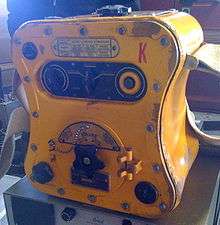
SCR-299
The SCR-299 was a U.S. Signal Corps mobile military communications unit used during World War II.
History
The SCR-299 "mobile communications unit" was developed to provide long-range communications during World War II. The US Military sought improvements of range, flexibility and durability over its existing SCR-197 and SCR-597 transmitters. In 1942, Hallicrafters Standard HT-4 was selected as the SCR-299's transmitter, known subsequently by its military designation as the BC-610. The SCR-299 was first used on November 8, 1942 during Operation TORCH involving companies of the 829th Signal Service Battalion establishing a radio net that could exchange messages between beach-landed forces and bases in Gibraltar. Despite initial problems unloading the sets from convoy ships, the SCR-299s served until the installation of permanent Army Command and Administrative Network stations. According to US Army military historians, "General Dwight Eisenhower credited the SCR-299 in his successful reorganization of the American forces and final defeat of the Nazis at Kasserine Pass."
90.3 ABC Coast FM
90.3 and 95.3 ABC Coast FM is an ABC Local Radio station based in Maroochydore. The station broadcasts to the Sunshine Coast region of Queensland. This includes the towns of Nambour, Caloundra, Noosa and Gympie.
It was originally set-up to target the youth market and broadcast to the Sunshine Coast from a studio at 612 ABC Brisbane. The station is now a news, current affairs and adult contemporary music station.
Like most other ABC Local Radio stations throughout regional Queensland, ABC Sunshine Coast offers local breakfast and morning programs between 5am and 11am with an additional local drive program between 3pm and 6pm. All other programming originates from metropolitan ABC stations, such as the early afternoon and evenings programs which are broadcast from 612 ABC Brisbane.
In late September 2014, to fall in line with most ABC Local Radio stations in Queensland, ABC Sunshine Coast began broadcasting their own local edition of The Rural Report, broadcast at 6:20am during the local breakfast program, presented by a Sunshine Coast-based rural reporter. Upon the launch of the local Rural Report, ABC Sunshine Coast also began taking statewide rural affairs program, The Queensland Country Hour, between midday and 1pm.

Survival radio
Survival radios are carried by ships and aircraft to facilitate rescue in an emergency. They are generally designed to transmit on international distress frequencies. Maritime systems have been standardized under the Global Maritime Distress Safety System.
History
The use of radio to aid in rescuing survivors of accidents at sea came to the forefront after the sinking of the RMS Titanic in 1912. Lifeboats were equipped with spark gap transmitters such as the Marconi Type 241, c. 1920. These operated using Morse code on 500 kHz, the international distress frequency at the time. This frequency had the advantage of long range due to ground-wave propagation and was constantly monitored by all large ships at sea after the Titanic's sinking. However, due to its wavelength of 600 meters, a long antenna was required to achieve good range. Long wires on the order of 1/4 wavelength held up by kites or balloons were often used. Spark-gap continued to be used in lifeboats long after the technology was banned for general communication.
SCR-68
The SCR-68 (SCR was a military term meaning Set, Complete, Radio) was a military radiotelephone used by the US Army Signal Corps as an aircraft radio in the waning months of World War I. Due to its many problems, primarily its inability to communicate with other radios, like its ground component the SCR-67 or the larger truck mounted SCR-108, over large distances, the SCR-68 quickly became obsolete. Nonetheless, the SCR-68 was one of the first steps towards developing more effective messaging between pilots and commanders, even beyond military usage.
Capabilities
The SCR-68 had a few distinct characteristics that separated the SCR-68 from other types of radio. The SCR-68 operated at 750 kHz (400 meter wavelength), using a long wire antenna reeled out behind the aircraft. It could receive and transmit messages over a maximum range of eighteen miles. The artillery observer (navigator) managed the SCR-68, receiving and relaying messages for the pilot. During World War I, most planes were two-person open-cockpit aircraft. Instead of communicating between themselves in the air, the pilot and the observer sent messages through the SCR-68 where the headphones would eliminate most outside noises. Like a private telephone line, the pilot and observer could communicate with each other; however, this action prevented the SCR-68 from receiving any transmissions.
Podcasts:

-
by GWAR
-
by Keith Sweat
-
by Keleton Dmd
-
by Skatalites
Sex Cow
by: GWARBarnyard Stomp
All the animals
Barnyard Stomp
All the animals
Barnyard Stomp
all the animals and you
Barnyard Stomp
All the animals
Barnyard Stomp
All the animals
Barnyard Stomp
all the animals and you
I got a dog
I got a cat
I got a hog
I got a bat
I got a monkey fish
I got a funky fish
I got a pig log dig dog
Turkey log
Corny Cobb
Bag dang ding dong
Slap a dappy wiggy wam
Sex Cow!
Barnyard Stomp
All the animals
Barnyard Stomp
I'm stomping animals
Barnyard Stomp
I'm stomping animals
with you
Barnyard Stomp
All the animals
Barnyard Stomp
I'm stomping animals
Barnyard Stomp
I'm stomping animals
with you
With you
With you
I got you
got you
got you
Down in the dark where the wild things grow
We're in there where the people don't go
Licking and sticking and piercing the pud
Blowing and hoeing and covered in mud
We don't care what the people say
Every day is tree frog day
Still they say we live in scuz land
But that's where I met my cuzband
Sex Cow!
Sex Cow!
Sex Cow!
I'm in love with a crazy sex cow
Baby I don't even know your name
Once you love
sex cow
Ain't nothing gonna be the same
You're just a sex cow
sex cow
